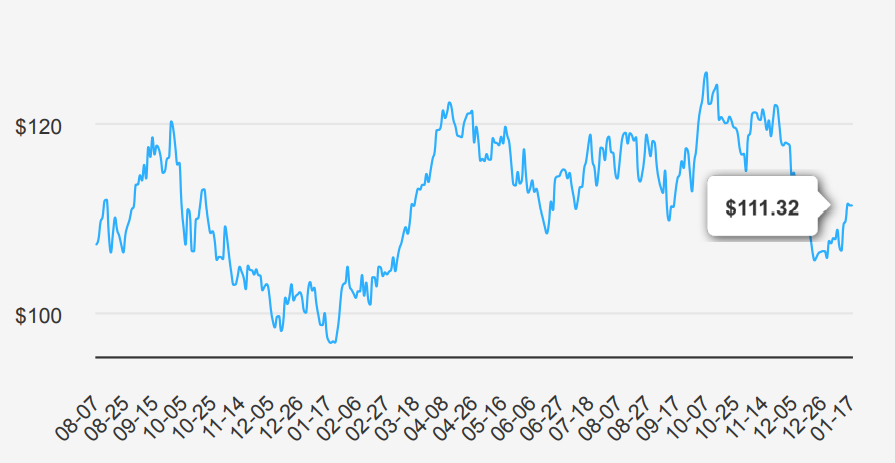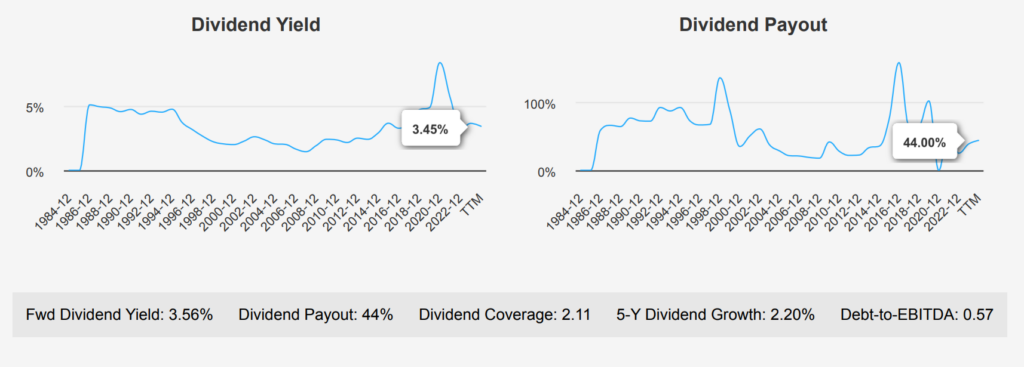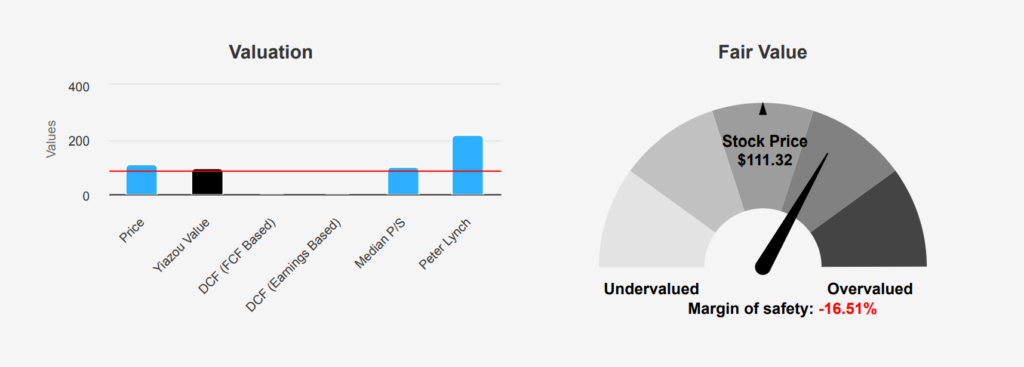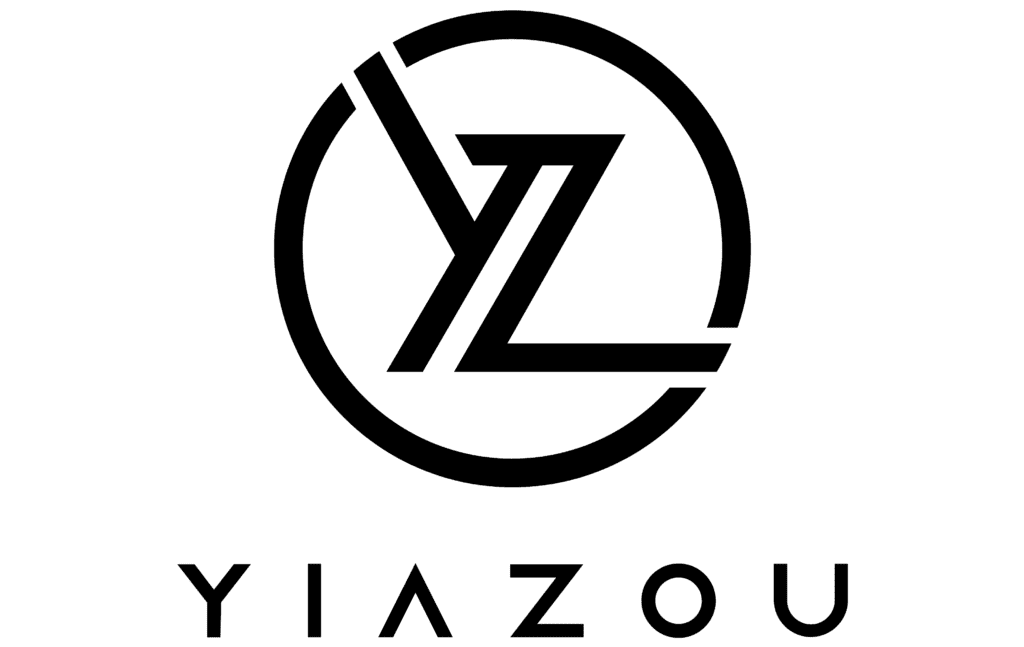
ExxonMobil Stock: Investment In Global Oil and Gas Operations
ExxonMobil (XOM) is an integrated oil and gas company that explores for, produces, and refines oil worldwide. In 2023, it produced 2.4 million barrels of liquids and 7.7 billion cubic feet of natural gas per day. At the end of 2023, reserves were 16.9 billion barrels of oil equivalent, 66% of which were liquids. The company is one of the world’s largest refiners, with a total global refining capacity of 4.5 million barrels of oil per day, and is one of the world’s largest manufacturers of commodity and specialty chemicals. ExxonMobil stock is currently trading at ~$111.3. Let’s explore XOM stock forecast 2025 in detail.

2024 EPS Trends and 2025 Forecast
XOM reported an EPS (Earnings Per Share) without NRI (non-recurring items) of $1.92 for Q3 2024, down from $2.14 in Q2 2024 and $2.27 in Q3 2023. This reflects a sequential decrease and a year-over-year decline, indicating pressures on profitability within the quarter. Revenue per share also declined to $19.675 from $20.845 in Q2 2024, continuing a trend from $22.005 in Q3 2023.
ExxonMobil’s gross margin for the quarter was 22.71%, slightly below the 5-year median of 23.45% and significantly higher than the 10-year low of 4.55%. This indicates a relatively stable cost structure, though it remains under the peak levels seen in the past decade. The company’s aggressive share buyback strategy, with a 10-year buyback ratio of 0.40%, indicates a consistent effort to return value to shareholders by reducing the number of shares outstanding, thereby enhancing EPS through share repurchases. However, the past year’s buyback activity showed a negative ratio of -10.90%, suggesting a reduction in buyback intensity recently.
Looking forward, analysts project a revenue estimate of $348.6 billion for 2024, with a slight decrease to $325.9 billion in 2025, before an expected uptick in 2026. The estimated EPS for fiscal years 2025 and 2026 are $7.751 and $7.771, respectively, pointing to stable, if modest, earnings growth. The next earnings report is on January 31, 2025, which will provide further insights into ExxonMobil’s financial trajectory amid ongoing market fluctuations and industry dynamics under the XOM stock forecast 2025.

XOM Stock: ROIC and Shareholder Value Creation
XOM stock demonstrates effective capital allocation and value creation. Over the past five years, its Return on Invested Capital (ROIC) has a median of 6.13%, but the latest figure stands at 8.96%, which exceeds the Weighted Average Cost of Capital (WACC) of 7.08%. This indicates that XOM is generating positive economic value as its ROIC surpasses its capital costs.
In terms of financial efficiency, the company’s Return on Equity (ROE) is robust, with a recent figure of 14.69%, reflecting strong profitability and effective use of shareholders’ equity. Over a decade, XOM’s ROE ranged from -12.87% to 30.66%, showing resilience in delivering shareholder returns even amid fluctuating market conditions.
Despite a median ROC (ROIC) of 6.13% over five years, the current ROIC of 8.96% highlights XOM’s improved operational efficiency and profitability. This performance, alongside maintaining WACC below its ROIC, positions XOM as a company that consistently creates value for its investors by earning returns above the cost of capital. This is a positive under XOM stock forecast 2025.

2025 Growth Outlook and Financial Health
XOM stock has demonstrated steady dividend growth, with a five-year growth rate of 2.20% and a three-year rate of 1.90%. The most recent quarter saw a dividend increase from $0.95 to $0.99 per share, reflecting continuing confidence in its financial performance. This growth is supported by a moderate forward dividend yield of 3.56%, slightly below its 10-year median yield of 3.72%, indicating a stable dividend environment under XOM stock forecast 2025.

XOM’s Debt-to-EBITDA ratio stands at 0.57, well below the industry caution threshold of 2.0, indicating strong financial health and excellent debt servicing capacity. This low leverage positions ExxonMobil favorably compared to its peers in the energy sector, many of whom operate with higher debt levels.
The estimated future dividend growth rate of 4.34% suggests an optimistic outlook, driven by robust earnings and disciplined capital management. Despite past fluctuations in the dividend payout ratio, currently at 44.0%, XOM maintains a sustainable balance, enhancing investor confidence.
The next ex-dividend date is on February 14, 2025, ensuring shareholders continue to benefit from regular, quarterly dividend payments. This consistent dividend policy underpins XOM’s appeal as a reliable income-generating investment in the energy sector.

XOM Stock: Market Price vs. Intrinsic Value
XOM is currently trading at $111.32, which exceeds its intrinsic value of $95.53, suggesting a negative margin of safety of -16.53%. This indicates that the stock holds overvaluation based on intrinsic value analysis. The TTM P/E ratio stands at 13.86, comfortably below the 10-year median of 16.21 but significantly above the historical low of 6.93. This suggests the stock holds moderate value relative to earnings, although not as attractively as during its historical lows. The forward P/E ratio at 14.34 is slightly higher, indicating market expectations of earnings growth.
The TTM EV/EBITDA ratio of 6.82 is close to the 10-year low of 4.03 and below the median of 7.88, suggesting a relatively attractive valuation in terms of earnings before interest, taxes, depreciation, and amortization. However, the TTM P/B ratio is 1.82, slightly below the 10-year median of 1.92, indicating the stock holds a modest valuation relative to its book value. The P/S ratio at 1.38 is above the 10-year median of 1.23, reflecting higher sales valuation compared to historical norms.
Analysts have set a price target of approximately $129.74, which implies a potential upside from the current price. The stock’s TTM Price-to-Free-Cash-Flow ratio is 14.24, well below the median of 22.96, suggesting healthier cash flow multiples compared to its historical context. Despite the negative margin of safety, the stock may still be attractive for investors seeking moderate growth, as analyst sentiment appears cautiously optimistic with a generally positive outlook under XOM stock forecast 2025.

Revenue Declines vs. Financial Stability
XOM stock presents a mixed risk profile. The decline in revenue per share over the past 12 months may be a concern for investors (focusing on growth). This trend could indicate a potential slowdown in business operations or market challenges that the company needs to address. However, it does not necessarily reflect long-term performance and could be influenced by external factors like fluctuating oil prices or temporary operational hurdles.
On the positive side, XOM’s financial integrity and strength are strong indicators of stability. The Beneish M-Score of -2.71 suggests that the company is unlikely to engage in financial manipulation, providing a layer of trust in its financial reporting. The PB ratio is close to a 3-year low presents a potential buying opportunity, indicating the stock holds undervaluation relative to its historical performance. Moreover, the Altman Z-score of 4.16 reflects robust financial health, suggesting a low probability of bankruptcy in the near future. These factors combined indicate that despite the current revenue challenges, XOM maintains a strong foundation and could be a resilient investment in the energy sector
XOM Stock: Insider Trends and Institutional Ownership
In analyzing insider trading trends for XOM over the past year, there appears to be minimal activity among the company’s directors and management. Over the past 12 months, there was only one insider buy and three insider sells. Notably, the last six months have shown no insider buys or sells, indicating a current stabilizing trend or lack of significant movement among insiders. The insider ownership stands at a moderate 0.78%, suggesting that company executives do not hold a significant portion of the company’s shares. This level of ownership might imply limited personal stake, which could affect how insiders perceive the impact of their transactions on stock performance.
Institutionally, XOM is heavily owned, with institutional ownership at 72.23%. This robust institutional presence indicates significant interest and confidence from large investors in the company’s longterm prospects. Overall, the lack of insider trading activity combined with substantial institutional ownership suggests that insiders might be confident in the company’s current strategy and financial health but do not see immediate personal incentives to alter their holdings.

Dark Pools and Trading Volume Insights
XOM demonstrates robust liquidity, which is crucial for its trading dynamics. With a daily trading volume of 10,072,558 shares, XOM maintains considerable activity in the market, although it falls short of its two-month average daily trade volume of 15,824,488 shares. This discrepancy may indicate a temporary decline in trading interest or market volatility, but overall liquidity remains strong.
The Dark Pool Index (DPI) of 43.54% suggests that a significant portion of XOM’s trading occurs in dark pools, which are private exchanges for trading securities away from the public eye. A DPI of 43.54% indicates that nearly half of the trading volume is on these less transparent venues, which can impact price discovery and market dynamics.
Despite the lower-than-average volume, XOM’s notable liquidity ensures that large trades holds minimal market impact, which is beneficial for institutional investors and traders seeking flexibility. The active trading environment, along with substantial dark pool activity, highlights XOM’s appeal in the market, offering opportunities for both long-term investors and short-term traders.
Political Perspectives on ExxonMobil Investments
On December 10, 2024, Representative Kevin Hern, a Republican from the House of Representatives, made a purchase of ExxonMobil (XOM) shares valued between $1,001 and $15,000. This transaction was reported on January 15, 2025. This acquisition follows a previous sale of ExxonMobil shares by Representative Jared Moskowitz, a Democrat, which occurred on November 8, 2024, and was reported on December 9, 2024. Moskowitz’s sale was also valued in the range of $1,001 to $15,000. The timing of these trades is intriguing, as it shows a shift in investment strategy between these two congressmen from opposing parties within a relatively short timeframe. Such transactions may reflect differing perspectives on the energy sector’s future prospects or personal investment strategies that align with their party’s policy priorities or personal financial goals. These trades underscore the dynamic nature of investment decisions in response to market and policy expectations.
Disclosures:
Yiannis Zourmpanos has a beneficial long position in the shares of XOM either through stock ownership, options, or other derivatives. This report has been generated by our stock research platform, Yiazou IQ, and is for educational purposes only. It does not constitute financial advice or recommendations.






